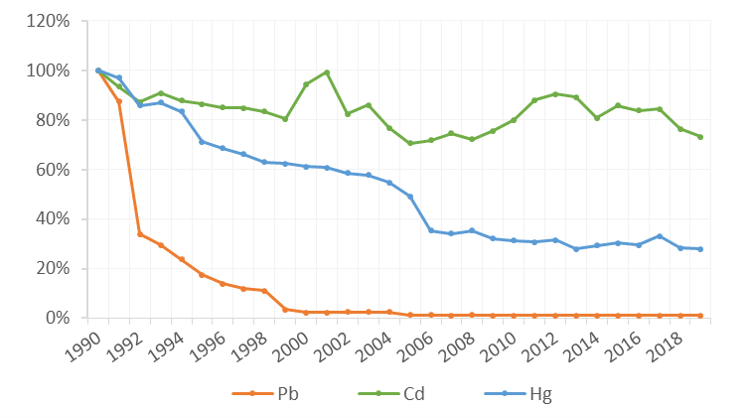Heavy metals
Of the heavy metals, lead, cadmium, mercury, arsenic, chromium, copper, nickel, selenium, and zinc emissions have been reported since 1990. All are reported in tons, although they represent different environmental risks.

Figure 1. Trend in lead, cadmium and mercury emissions between 1990 and 2019
Lead (Pb) is a severely toxic heavy metal. In 1990, 95% of lead emissions came from road transport in Hungary. Due to its harmful effects on health, the use of leaded gasoline was banned in 1999. As a result, in 1999, lead emissions fell to 4% of the 1990 level. From that time, main sources of lead emissions (in decreasing order) are residential heating, wear of tires and brakes, electric power generation, glass production, and use of fireworks.
Mercury (Hg) emissions decrease from year to year with less variability. The emitted amount of mercury in 2019 was 72% lower than in 1990 and 54% lower than in 2000. The toxicity of mercury depends on the form of the compound present in the atmosphere. Mercury becomes a problem for the environment when it is released from rock and ends up in the atmosphere and in water. These releases can happen naturally. Both volcanoes and forest fires send mercury into the atmosphere. Human activities, however, are responsible for much of the mercury that is released into the environment. The burning of coal, oil, and wood as fuel can cause mercury to become airborne, as can burning wastes that contain mercury. It these cases, mercury can be severely toxic. Industrial sources of mercury are electric power generation, energy-intensive industrial processes (cement, glass, iron and steel production). In addition, 0.8 t mercury is still emitted today, from the use of batteries.
Cadmium (Cd) is a dangerous, carcinogen pollutant. Its main sources are residential heating, electricity production, glass production and smoking, as tobacco contains cadmium. Emission from cadmium have decreased by 27% since 1990.




